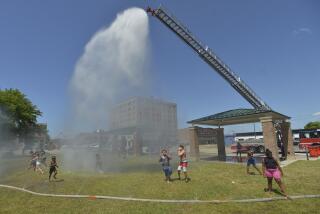Polar vortex moves east and south, widening deep freeze to Atlanta
Record-setting cold stunned the Southeast on Tuesday as the chilly “polar vortex” parked over the northern Midwest extended eastward, prompting officials to cancel school and open emergency warming and homeless shelters in areas unaccustomed to sub-zero temperatures.
The Midwest freeze set in Monday, when subzero temperatures broke records in Chicago, at 16 degrees below zero and Fort Wayne, Ind., at minus 13. Oklahoma and Texas also saw record-setting cold, with wind chills of 40 below zero.
Illinois Gov. Pat Quinn and Indiana Gov. Mike Pence issued disaster declarations. More than 500 Amtrak passengers -- including some from Los Angeles and San Francisco -- spent the night stranded by snow on three trains headed for Chicago and were rerouted by bus Tuesday morning.
PHOTOS: Deep freeze in the Midwest
Airline cancellations and delays prompted by the severe weather declined slightly Tuesday. As of late morning, the nation’s airlines had canceled about 2,400 flights and delayed another 3,400 flights, according to the air traffic monitoring site Flightaware.com. Most of the cancellations are in major East Coast hubs such as Chicago, Boston and New York. By comparison, the nation’s airlines canceled about 4,000 flights on Monday and delayed another 8,000, according to Flightaware.com.
Temperatures reached 6 degrees below zero at a weather station in the north Georgia mountains Tuesday -- the coldest in decades. Windchill temperatures in many parts of the state dropped below zero -- colder than many cities in Alaska on Tuesday, meteorologists said.
“Aside from the bone-chilling extremely cold temperatures and wind chill factors, the most widespread impact in the state is school closures,” said Ken Davis, spokesman for the Georgia Emergency Management Agency. School was closed in Atlanta and in 66 of the state’s 159 counties, 15 of which had also opened warming shelters, Davis said.
He said there had been no reports of weather-related fatalities, but that officials closed schools primarily to prevent children from waiting for buses outside, where they might get frostbite.
Davis, who is based in Atlanta, said there had been scattered reports of power outages and water main breaks related to the cold weather, but no major damage.
When it came to the deepest freeze, the weather was worse farther north.
“The harshest is in the northern parts of the country: Minnesota, the Dakotas and into the Great Lakes,” with wind chill temperatures of less than minus 20 degrees, said Brian Hoeth, a meteorologist with the National Weather Service in Fort Worth.
Western New York, which was hit with 18 inches of snow Tuesday and 50 mph winds, saw temperatures dip to minus 33 degrees with wind chill on Tuesday, Hoeth said. Western Pennsylvania registered minus 28 degrees.
“That’s the worst area of the country right now,” Hoeth said.
Atlanta was the coldest Tuesday since 1996, he said. Low temperature records were broken in Georgia, Alabama and Tennessee.
PHOTOS: Deep freeze in the Midwest
“That was the hardest-hit area in our region,” he said.
An Atlanta homeless shelter was busy answering phones, trying to find warm beds for those stuck out in the cold.
Paul Ballew is a caseworker at the downtown Metro Atlanta Task Force for the Homeless, which usually shelters about 700 people per night during the winter, but was expecting a thousand each night during the cold spell.
“It was 6 degrees this morning when I came into the office -- wow, it went up to a balmy 14 degrees,” Ballew said as he checked the temperature.
“We are not turning anyone away,” he said. “We also have an outreach team that is going under bridges and other places where people congregate and [asking] people to come in. Some are, some are refusing.”
For those who refuse, he said other groups have sent staff out to distribute blankets and other supplies. Ballew said the shelter has been trying to gather donated hats, coats and gloves.
“It’s going to get really, really, frigidly, brutally cold and we’re going to get a lot of people -- I’m already getting calls from women with children. They’re not used to this cold and we’re trying to help them get out of it,” he said.
For Brian Kinsey, who runs an Atlanta-area trucking company, the weather was not as bad as he had expected.
Kinsey is chief executive of Lithonia, Ga.-based Brown Integrated Logistics, which operates thousands of trucks east of the Mississippi and south of the Ohio River. Their trucks are not equipped with the engine block and fuel heaters that are standard for those operating farther north. He had feared their diesel fuel might freeze or “gel up” overnight. But they stored as many tractor-trailer cabs as they could inside, turned them away from the wind or idled them -- and didn’t have any major problems, he said.
“Our drivers were pretty well prepared,” Kinsey said. “We took every kind of precaution we could take knowing we’re not really set up for that kind of weather down here.”
While the cold was less severe farther south, it was so unusual that it prompted concern from public safety officials and farmers, particularly in places such as Florida with sensitive citrus crops.
“Luckily, most of the crops grown in Florida are in the southern parts of the state where the temperatures are warmer,” said Aaron Keller, a spokesman for the Florida Department of Agriculture, who said the coldest spots have been in the northern Panhandle where the impact on farmers was “not alarming.”
Hoeth said the weather’s impact on Florida’s crops this week will likely be minimal.
“The cold air finally got to areas of Florida yesterday, but today they’ll already be back in the 50s,” he said, with the coldest spots north of the larger groves in central and southern Florida.
Hoeth said the cold weather is expected to move out of affected areas to the north and east on Wednesday, so that by Thursday, “the rest of the country kind of warms up -- relatively speaking.”
“Today and into tomorrow morning is going to be the tail end of the widespread impacts across the country. There’s still really cold air up in the central plains, Minnesota, the Dakotas -- but the rest of the country starts to moderate,” Hoeth said, with temperatures climbing into unseasonably balmy 60s and 70s in Florida, Louisiana and Texas.
ALSO:
What is a ‘polar vortex’ and why is it so dangerous?
Utah gay couples in limbo as court puts marriages on hold
‘Jihad Jane,’ Pennsylvania woman linked to terror plot, gets 10 years
Los Angeles Times staff writer Hugo Martin contributed to this report.
More to Read
Sign up for Essential California
The most important California stories and recommendations in your inbox every morning.
You may occasionally receive promotional content from the Los Angeles Times.











